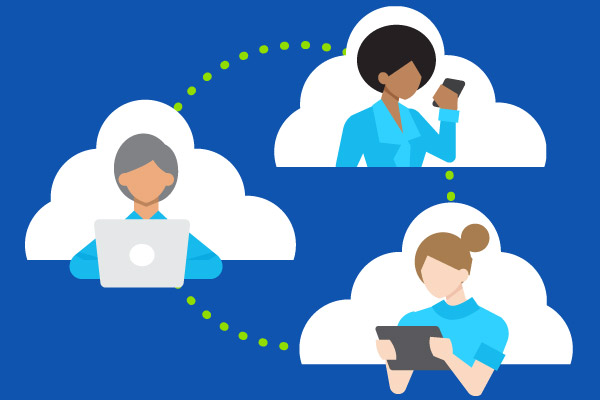Unleash your growth with fixed-mobile convergence
This post was sponsored by AT&T Business, but the opinions are of Cavell Group and don’t necessarily represent positions or strategies of AT&T Business.
You’re traveling for work using your mobile phone and tablet, and need to have a quick chat with a colleague to meet a critical deadline. Looking at the time, you realize this person is likely at lunch but the launch team needs an answer right now.
You’re excited because you can still reach them through their mobile number no matter where they are. Because your company uses fixed-mobile convergence (FMC), your call will ring their desk phone, laptop, or any other device connected through their mobile number.
During your conversation you’re able to easily elevate the call to a WebEx Meeting through an easy-to-access pop-up on your phone. You’re able to switch from audio to video, screen share the document to review, and add the launch team leader to the call. What could have taken hours was completed in minutes. Thanks to fixed-mobile convergence with mobile-first collaboration, your launch will move forward without delay.
Mobile devices have become an integral tool for businesses to communicate while on the go. In the scenario above, the use of mobility and the ability to use one phone number to reach someone no matter which device they were on, played an essential role in connecting the necessary parties to meet a deadline. Recent data estimates that smartphone penetration reached 72.7% of the US population in 2021 and is now projected to have risen to 86%. As a result of this significant penetration, more and more smartphones are being adopted in the enterprise as endpoints, a trend that is expected to persist as market awareness increases. As such, mobiles are predicted to be the device of the future for enterprise communications.
Introduction: The future of enterprise communications
Cavell’s data shows that 52% of employees at a US company have a mobile device. Most notably, mobiles are particularly prevalent in the small business where 45% of companies in the 1-9 employee segment provide nearly all their employees with a mobile device.
Much of this growth can be attributed to changing working practices. Since the pandemic, businesses have had to adjust to their employees working remotely or in a hybrid setting, which is now the norm for many workers. Cavell Group’s latest research reveals that if given the option, 41% of employees would work in the office for 1-3 days a week, while 10% would choose to exclusively work remotely. In another study conducted by Stanford University, in March 2023 12% of US workers were fully remote and 28% worked in a hybrid set-up. Consequently, businesses are facing several challenges in supporting this new way of working and ensuring productivity remains unhindered.
When looking at cloud communications, the US is the most advanced marketplace globally with strong adoption driven by prominent US-based hyperscalers such as Cisco. Cavell Group’s latest research shows that the US market is at over 51% penetration with just under 44 million deployed Unified Communications as a Service (UCaaS) users, as of Q4 2022. By 2027, this is forecasted to grow to over 69 million users and reach almost full penetration. With rising cloud awareness and acceptance, only 4% of US businesses using a legacy PBX system are not planning to transition to a cloud-based PBX in the next five years.
Cavell Group estimated that there were just over 1 million mobile-enabled cloud communications users in the US at the end of 2022. This is set to rise to 7.3 million users by 2027.
Why is the demand for cloud-based mobile phones increasing?
Cavell Group’s data reveals a significant decline in demand for fixed-line services in the enterprise, paving the way for robust growth in mobility services. In the US, the current total of available UCaaS users stands at 85.8 million, but Cavell anticipates this will decrease to 76.5 million users by Q4 2027. This shift can be attributed to businesses buying collaboration-only licenses for their employees, without any integrated business telephony capabilities, and then assigning a business phone number to a mobile device for external communication. As the influence of mobile devices is now extending to business communication, mobile users are expected to represent a significant proportion of future cloud communications users as more and more workers adopt a mobile-first persona at work.
As more and more employees use their mobile as their primary device for personal and business communications, the demand for mobile-first communications is increasing. Various types of mobile PBX technology have existed in the unified communications (UC) segment for a long time and have seen some success, most notably in the Nordic region—countries in Northern Europe and the North Atlantic, which is one of the few areas with high fixed-mobile convergence adoption rates.
The trend towards fixed-mobile convergence
Cavell Group are currently tracking a growing demand for fixed-mobile services in developed markets, primarily fueled by the increasing demand for remote and hybrid work. Mobile innovation in the form of electronic SIM (eSIM) technology, which allows you to connect mobile devices to networks without physical SIM cards, can now enable a single corporate number for company-provided mobiles, desk phones, and applications on a laptop. This offers unparalleled flexibility, enabling users to seamlessly transfer between different devices (mobile, desk phone, application, meetings or video room systems) and networks (Wi-Fi and 5G for business) with full control over the handling and routing of their calls.
In addition, dual SIM technology enables personal and business phone numbers to be supported on the same device, the mobile phone, for both personal and business communications. This creates a single identity for workers and avoids the annoyance and potential compliance risk of having two mobile phones for work and personal use. Although a business and private number share one device, a dual SIM enables the user to keep their personal data and browsing activities separate and private from their business. This is ideal for both business and bring your own device (BYOD) mobile arrangements.
To deliver an enterprise-grade mobile-first solution, there is a requirement for a tight integration between carrier networks and industry-leading UCaaS platforms to provide a best-in-breed solution for enterprises. Crucially, direct access to the network, including access to 5G capabilities, can ensure Quality of Service and call quality. Network carriers can also bring native mobile features to the UCaaS solution such as single voicemail, extension dialing and call recording for compliance purposes; all features that UCaaS providers cannot provide themselves.
Benefits of fixed-mobile convergence and mobile-first collaboration
The crucial role this network integration will bring to the enterprise is secure and compliant communications as this technology allows workers to easily distinguish between private and business conversations on a single device. Since the pandemic, security has become a major concern for enterprises due to workforces working remotely, and this was the second highest communications priority for larger organizations in the US in 2022.
With these enterprise concerns in mind, mobile phones for business are anticipated to become the focal point for all communications, which will play a pivotal role in certain verticals. For instance, for the 7.6 million employees working in the financial and insurance sectors in the US, the importance of compliant and regulated communications delivered by mobiles is paramount. There will continue to be a diversity of businesses, customers, and clients they need to reach on a day-to-day basis. For this reason, it’ll continue to be important to have quality, reliable fixed-mobile connectivity and the flexibility it provides.
Moreover, there are also a huge number of people in the workplace who are entirely remote. Emergency-first responders fit into this category and are a core use case for mobile-first communications and collaboration. This technology will allow responders to communicate clearly in high-stress, urgent situations, particularly in remote environments where exceptional call quality and high availability is crucial. At times, these first responders may be connecting with call centers that rely on fixed lines or UCaaS. In these cases, FMC is helpful to provide flexibility for reliable, secure connectivity.

The future of networking: How to solve for enterprise needs
The future of networking is now. Rick Welday, EVP-Enterprise Markets at AT&T Business, shares the how we’re bringing a new standard of networking to our customers.
Is mobile-first communication being adopted?
Despite the ability to use fixed-line communications on mobile devices being available for years, the solution has only recently become advanced enough to provide a viable solution to enterprises.
When the technology was first created, it enabled basic functionalities on mobile phones such as simultaneous and sequential calls. Over time, this developed into an over-the-top UC app for voice and video, however these apps would generally require Wi-Fi connectivity as cellular connectivity was not able to handle the bandwidth requirement. Cavell Group’s latest industry survey revealed that most providers still only offer mobility solutions using a softphone client or a separate app that can struggle when running over the top of a cellular network.
In contrast, enterprise mobile solutions have been developed to provide a far more sophisticated experience to customers, allowing the functional integration of the UCaaS application with the cellular network. As a result of this mobile innovation, there has been significant growth in the use of mobile PBX services due to their reliability and security for communications on-the-go. This has prompted several UCaaS providers to launch sophisticated mobile solutions to cater to mobile workers.
Cavell Group tracks the use of mobile PBX services and estimated that there were just over 1 million mobile-enabled cloud communications users in the US at the end of 2022. This is set to rise to 7.3 million users by 2027. In the future, the integration of cellular networks and UCaaS platforms will enable enhanced user experiences for workers, making mobility an integral means of communication and collaboration for enterprises.
Where does mobility add value to the end user and the enterprise?
The core benefit of a mobility solution with a functional integration to the network is the way it allows employees to maintain their business persona when not in the office.
A mobile number and device form an integral part of an employee’s business identity, on par with an email address. User identity and verification in the future is a key concern for enterprises—with more than 23% of organizations citing improving security as a top strategic priority. Mobile numbers provide one of the key unique identifiers for individual business users, providing the primary channel for two-factor authentication (2FA) and other verification methods.
As already explored, most workers who make calls on their mobile devices will currently use their personal mobile phone number to run those calls through a collaboration or UCaaS application. However, mobile technology has now developed to offer fixed-line services over a cellular network, eliminating this need for a separate application and enabling a single business phone number for every user. This enables strengthened hybrid working and productivity, as workers will no longer be limited to their office or home environment to work and collaborate effectively.
In addition, the removal of a separate app, as well as the use of one number across multiple devices, preserves the office experience and business persona of an employee, even when on the move. This is a core use case for businesses with Cavell Group’s enterprise research revealing that the ability to work from anywhere ranked high among the communications priorities of US businesses. This advanced mobility capability maintains the features of a traditional fixed-line service for added professionalism, for instance mobile hunt groups. As customer experience plays such a vital role in business strategy, a reliable mobility solution is paramount for employees in sales and marketing roles that require them to communicate with customers regularly and preserve their business identity, no matter where they are.
An integrated fixed and mobile solution also significantly improves the quality and security of phone calls and communications. The reliance on the carriers’ network architecture can enhance extensive QoS and end-to-end secure connectivity for secure, compliant, and reliable calling. The BYOD functionality is also an important way that mobile-first collaboration helps certain verticals maintain effective security practices, putting in place strong boundaries between personal and work communications from one device. It also enables users to not have to rely on Wi-Fi networks which can be unsecure and unreliable when travelling.
From a price standpoint, a fixed-mobile integration is an effective cost-cutting solution for the enterprise. Currently, while making calls on collaboration or UCaaS applications, most employees without a natively-integrated mobile solution will have to resort to data roaming while on the go. As this new wave of mobile technology relies solely on network services, it avoids expensive data roaming charges. It will also remove the need for redundant PSTN numbers and calling plans not being used by employees, which will help businesses streamline their communications practices.
How AT&T can help you with your mobile-first collaboration and fixed-mobile convergence
The AT&T network capabilities are a core foundation to their upcoming solution, AT&T Cloud Voice with Webex Go. The solution will extend smartphone devices and their assigned cellular number to a UCaaS platform, without having to open a separate application. AT&T has invested more than $135 billion in its wireline and wireless networks. The access to the reliable, secure AT&T network delivers nationwide coverage and will provide a series of functionalities to the mobile-first users1 who will benefit from this solution, including:
- The AT&T network will prioritize mission-critical and Webex Go application data in the network to ensure a consistent voice, video and collaboration experience. It will thus bring mobile quality of service to employees’ business applications.
- The AT&T 5G Network will be the latest wireless technology that can offer faster speeds, lower latency, and greater capacity compared to previous generations of wireless technology.
- AT&T will be able to carry voice calls over their Long-Term Evolution Network, enabling faster call setup times, higher quality voice calls, and simultaneous voice and data transmission on the same network.
- Service assurance will provide a clear and concise support program so enterprise customers will know exactly who and where to call. This means that AT&T will be able to react to any challenges to the network quickly and effectively.
- Extensive end-to-end security, with secure network connectivity between AT&T and Cisco Webex’s core network nodes.
In addition, the AT&T network uses next generation technology. It’s designed for wireless and wireline to work together, which enables for a mobile-first, fixed-mobile convergence strategy. Through the reliability of fiber and 5G, customers gain the bandwidth, speed, and low latency needed for a quality, mobile-first experience.
Conclusion
All businesses will have a large portion of their workforce that are mobile and are looking for ways to enable those workers to communicate effectively and efficiently. Communications that are optimized to run over cellular networks are a crucial way of serving the mobile workforce, and Cavell forecasts that adoption will expand rapidly as forward-thinking businesses embrace solutions like AT&T Cloud Voice with Webex Go.
AT&T and Cisco’s collaboration will enable enterprise and mid-market businesses to communicate effectively, securely and reliably on any device, fulfilling businesses’ requirements for collaboration on-the-go in a compliant way. The strength of this solution will not only rely on AT&T’s extensive wireless network and the numerous capabilities built into it, but also on Cisco’s industry-leading UCaaS solution, Webex, to deliver a powerful, enterprise-grade mobile-first collaboration solution to enterprises.
To learn more, please visit the AT&T Cloud Voice with Webex Go website at att.com/webexgo or contact your AT&T Business representative to connect with an expert who knows business.
1Features and functions described expected to be available upon launch.




Share
Share this with others